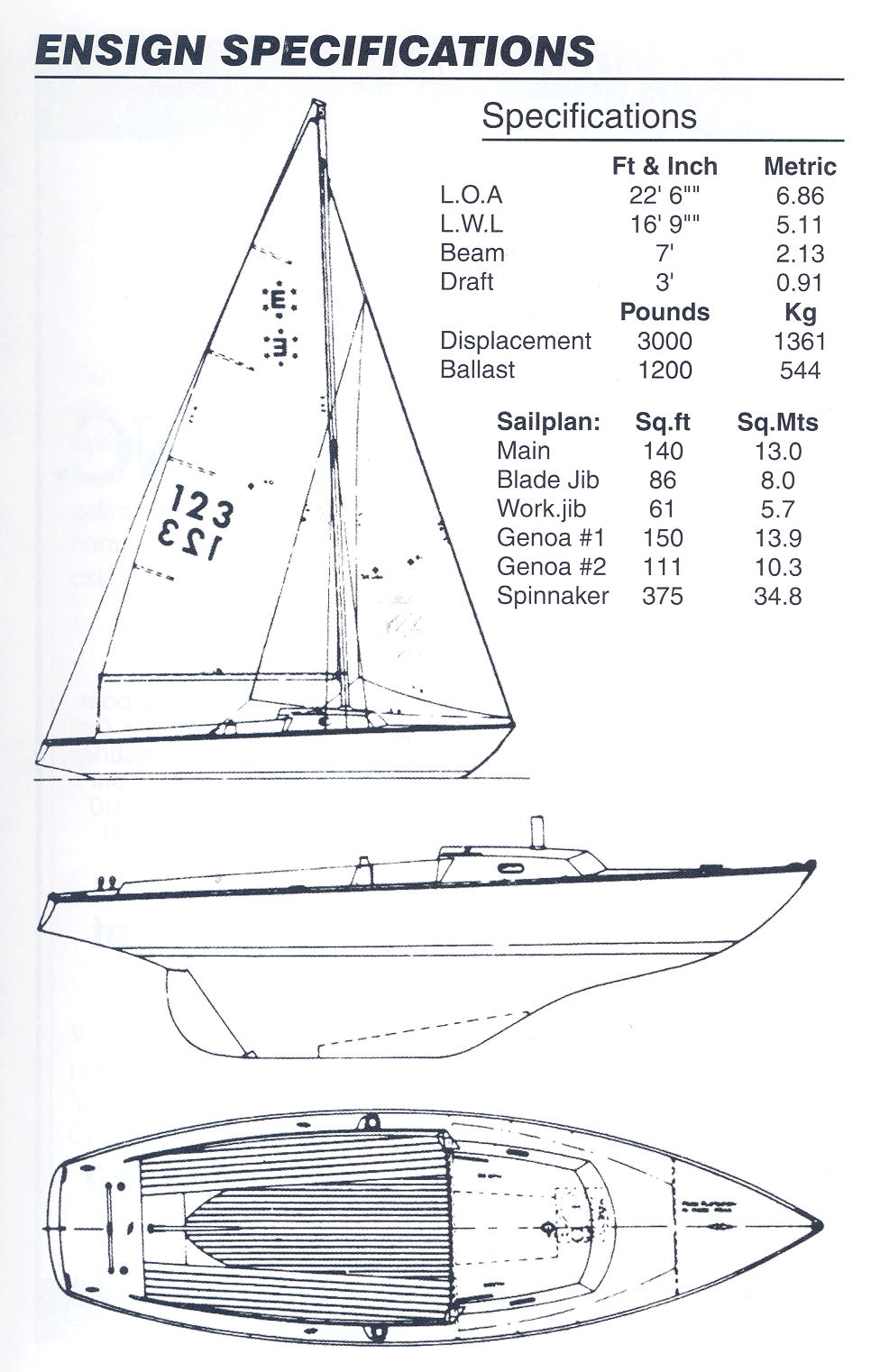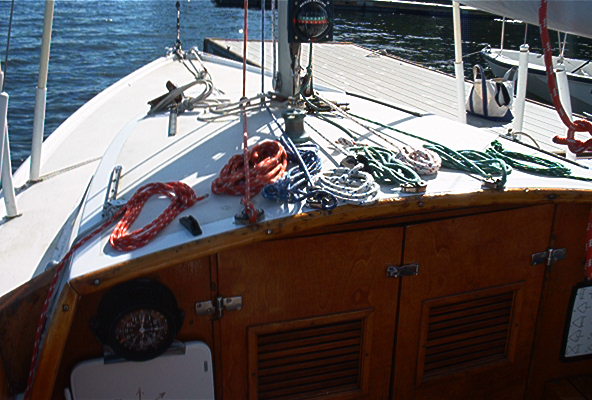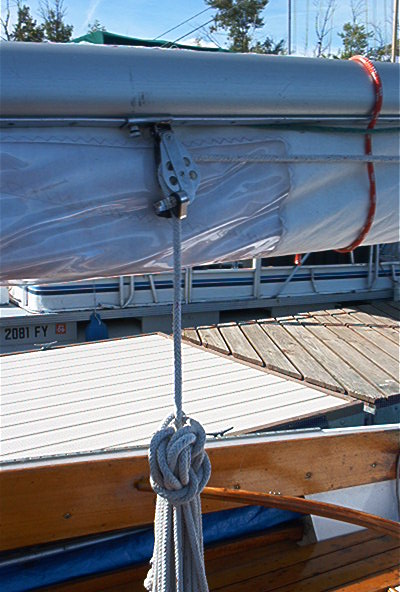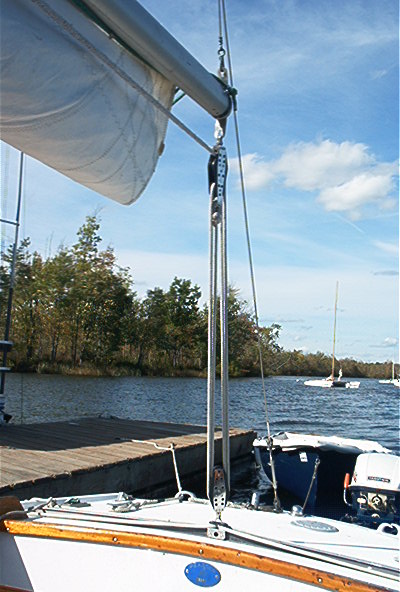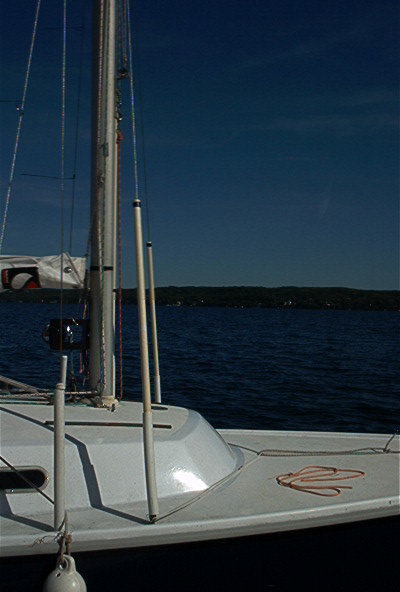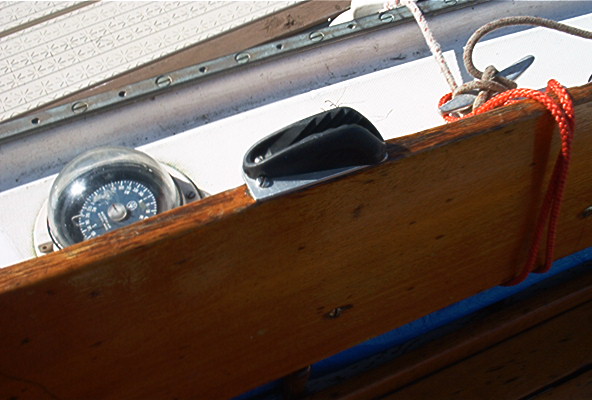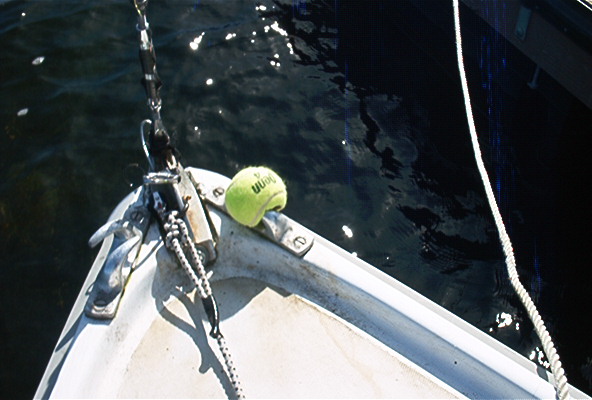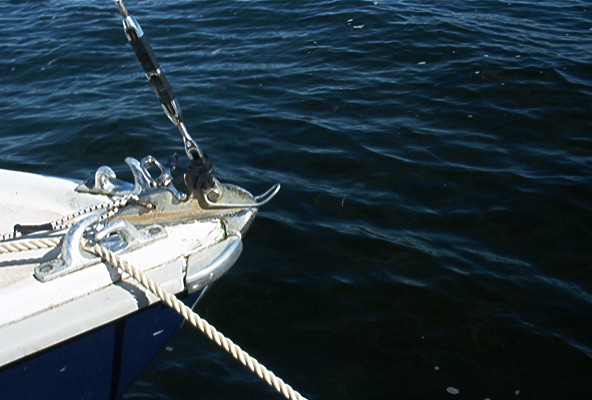Why an Ensign?
The Ensign fleet at SLSC has been certified as Fleet 72 by the National Ensign Class Association. We are very proud to be a part of one of the most active and strongest one-design class organizations in the country. One of the strengths of the Ensign Class has been its strict one-design rules. Hulls from the first year of production still compete on an even basis with the newest boats. The Ensign is actively raced in many fleets around the country and is supported by an active class association. Newer, faster boats come and go on a regular basis, but the classic design of the Ensign seems to go on forever. Loyal Ensign owners are convinced that their boat is just the best family day sailor/racer that has ever been designed. It's large, roomy cockpit makes it ideal for taking even seven friends out for a daysail. With its three-foot full keel and 1200 pounds of ballast, it has the feel of a boat much bigger than twenty-two feet. The full keel enables the Ensign to ride over the weeds which normally entangle blade keels and rudders. It's the ideal family racer also and can be competitively sailed with a two, three or four person crew. Construction of the first new Ensigns since Pearson went belly up in 1983 began in 2001. If you are considering a change of boats, or are just curious about Ensign sailing, the members of Fleet 72 would enjoy giving you a test drive. One small warning; once you get your hand on the tiller, you may get hooked. For the non-racing sailor, crewing on an Ensign is a great way to experience the fun and excitement of competitive sailing. There are many advantages to Ensign crewing including:
- Roomy, comfortable crew stations.
- Friendly, kind-hearted skippers who never utter a nasty word.
- In hard blows, you get wet from spray, not from swimming.
- Hot hors d'oeuvres served during the race (not available in New York State).
- No experience required. It's supposed to be a learning experience.
Ensigns are the largest class, by far, of full-keel, one-design sailboats in the United States. The 22 1/2 foot sloop was designed bt Carl Alberg and produced by Pearson Yachts of Portsmouth, Rhode Island. Since 1962, nearly 1800 Ensigns have been built.
Fleet Captain - EJ Holcomb
Contact the fleet captain (by clicking on the above link) if you are interested in sailing an Ensign.
Ensign Class Website
What are Class members talking about?
Interested in a used boat?
Find one here.
Boat Builder
Class Resources
North Sails Tuning Guide (from ECA)
Go Fast Tips
Quantum Sails - Want to sail your Ensign faster?
The Ensign fleet at SLSC has been certified as Fleet 72 by the National Ensign Class Association. We are very proud to be a part of one of the most active and strongest one-design class organizations in the country. One of the strengths of the Ensign Class has been its strict one-design rules. Hulls from the first year of production still compete on an even basis with the newest boats. The Ensign is actively raced in many fleets around the country and is supported by an active class association. Newer, faster boats come and go on a regular basis, but the classic design of the Ensign seems to go on forever. Loyal Ensign owners are convinced that their boat is just the best family day sailor/racer that has ever been designed. It's large, roomy cockpit makes it ideal for taking even seven friends out for a daysail. With its three-foot full keel and 1200 pounds of ballast, it has the feel of a boat much bigger than twenty-two feet. The full keel enables the Ensign to ride over the weeds which normally entangle blade keels and rudders. It's the ideal family racer also and can be competitively sailed with a two, three or four person crew. Construction of the first new Ensigns since Pearson went belly up in 1983 began in 2001. If you are considering a change of boats, or are just curious about Ensign sailing, the members of Fleet 72 would enjoy giving you a test drive. One small warning; once you get your hand on the tiller, you may get hooked. For the non-racing sailor, crewing on an Ensign is a great way to experience the fun and excitement of competitive sailing. There are many advantages to Ensign crewing including:
- Roomy, comfortable crew stations.
- Friendly, kind-hearted skippers who never utter a nasty word.
- In hard blows, you get wet from spray, not from swimming.
- Hot hors d'oeuvres served during the race (not available in New York State).
- No experience required. It's supposed to be a learning experience.
Contact us if you'd like to learn more about Ensign sailing.
- What is an Ensign and why are you people always talking about it?
It's a 22.5 foot, sloop-rigged, full-keel, designed by Carl Alberg, sailboat, that happens to be about the most popular full-keeled sailboat ever made. - Saratoga Lake has a few weeds. I heard that keelboats don't do well in the weeds.
The Ensign has a full keel, and the rudder is attached to the aft (back) end of it. See the drawing below. Anyway, because the boat's bottom is very smooth and the rudder doesn't protrude, the Ensign slips right through weeds - you won't even notice them! - How do you launch an Ensign? How deep does the water have to be?
You launch an Ensign just like any other boat, just with a bigger trailer than you would use for a dinghy. The Ensign draws 3 feet of water, so a launch with 4 - 5 feet of water, like we have at the North end of Saratoga Lake, will do fine. Most of us store our boats on jackstands or cradles in the winter, and use a professional hauler to get us to the water in the Spring. - How do you step the mast on an Ensign?
See Stepping the Mast on an Ensign. - How big of an outboard motor do you need?
We find that 2-4 horsepower is plenty on our lake. If you're planning to sail in an area with lots of current, you may want a bit more, but 3-4 horsepower seems to push the boat about as fast as it will go. Plus, a smaller engine is a lot easier to put on and take off. - How much do Ensigns cost?
See Buying an Ensign.
Note: despite extensive editing, some of the preceding items may contain opinions.
or Where They Go, How They Got There, and How They Stay There
Ensigns at the Saratoga Lake Sailing Club are assigned a position in the mooring area by the Rear Commodore. Recommended ground tackle includes a 150# mushroom anchor, and an appropriate length of galvanized chain, depending on water depth, leading to a mooring float. Mooring floats are recommended throughout the mooring area in order to safely accommodate the maximum number of boats in the limited area. A nylon pennant attached to the foredeck cleat secures the Ensign to the mooring chain. A dinghy or a club rowboat is used to reach the Ensign from the shore. Use of a private dinghy allows the Ensign owner to set sail directly from the mooring. At times, it is more convenient to motor the Ensign to the dock area to pick up day sailing guests. In either case, the Ensign is always ready-to-go without the need to push a trailer to the hoist and use the crane for a launch and retrieval procedure each time you would like to use your boat.
End of Season
In preparation for winter storage, the Ensign mast must be unstepped so that the boat can be moved to its winter storage location. Fleet 72 has developed a gin pole from an old 470 mast which makes this task simple and efficient, and can be done by two people. In actual practice, mast unstepping becomes a fleet activity so that the entire decommissioning procedure is accomplished with many helping hands. The mushroom mooring anchors are also removed so that the ground tackle can be inspected and the anchors stored on shore. Boat owners in the mooring field have developed a mooring hoist which is used in conjunction with the small Boston Whaler. Again, Fleet 72 functions as a group to see that all Ensign moorings are accommodated.
Winter Storage
Ensigns can not be removed from the water at the Sailing Club due to crane capacity and shallow water depth at the shoreline. Ensigns motor to the state launch ramp north of the 9P bridge. The unstepped mast can be left at the club. If the Ensign has a custom trailer, the owner backs the trailer down the ramp, and the Ensign is pulled onto the trailer. For the Ensign which is stored on a cradle or stands, a professional boat hauler is used to provide haul out services in much the same manner. The boat hauler will then transport the boat back to the Sailing Club, and position it for winter storage in the designated areas. Most Ensign owners use the mast as a ridge pole supported by tripods and cover the boat with the typical blue poly cover for snow and ice protection.
Start of Season
Maintenance work on the Ensign can be performed any time before launching. A light duty anti-fouling paint is all that is required in the fresh water of Saratoga Lake. The boat is transported to the State 9P ramp for launching and motored to the Club. The mast is stepped using the gin pole and the boat is ready for a summer of sailing pleasure.
| Length overall: | 22 feet 6 inches |
| Length waterline: | 16 feet 9 inches |
| Beam: | 7 feet |
| Draft: | 3 feet |
| Sail Plan: | |
| Main: | 140 square feet |
| #1 Genoa | 150 square feet |
| #2 Genoa | 111 square feet |
| Working Jib | 61 square feet |
| Spinnaker | 375 square feet |
| Weight: | 3000 pounds |
| Ballast: | 1200 pounds (lead) |
| Designer: | Carl Alberg |
| Builders: | Pearson Yachts 1962 - 1982 (Hulls 1 - 1776) |
| Ensign Spars 2000 (Hull 2000 and greater) |
If you've decided you must have a new Ensign, the choice is easy. Give Ensign Spars a call (look at the nice photos there). They'll be happy to talk to you about your new Ensign.
An Almost New Ensign
For most of us, we'll be considering the alternative, a previously loved Ensign. The good news is that the Ensign is about as "bullet-proof" as a boat could be, with its solid fiberglass, hand-laid hull of up to 3/4 inch thick in some areas. Its deck is fiberglass, cored with end-grain balsa. The spars are aluminum, and it is ballasted with lead. These boats can outlast their sailors. The other good news for us at Saratoga is that most Ensigns are in the Northeast, so most are within a reasonable distance. Their price often quite reasonable, running typically from $8000 for one in really good condition with a good sail inventory, to $3000 or less for one requiring some amount of restoration. Occasionally one will appear that has a lot of new race rigging, new paint, possibly a trailer, and a huge inventory of new sails that will sell for more.
The last Pearsons were built in about 1982, so at this point even a late-model Pearson will likely have required at least some amount of restoration. We believe that the amount of care the boat has received is the primary determinant of its price, not its year of manufacture, since the vast majority of the nearly 1800 boats were originally built in the 1960's. Properly cared for, even the earliest Ensigns can be like new. Ensign Hull #5 recently won the "most beautiful Ensign" award. Other low-number Ensigns continue to place highly in and win large regattas.
Here are a few online places to start your search for an Ensign:
The following are some articles, to be added to over time, that show how various things are done on the Ensign, from routine items like mast stepping and unstepping that are done twice a year, to restoration and enhancement projects that we'll hopefully be able to publish from time to time.
- How is the mast on an Ensign Stepped?
- What does the mooring gear look like?
- How do I restore an Ensign? (We add to this from time to time so check back occasionally.)
- How do I fly an Ensign Spinnaker?
Various projects undertaken by Ensign owners to repair or improve their Ensigns.
Fundamentals
- Ensign Spars, Builders of the Ensign 2000, Catalog of Ensign Parts, nice new boat photos
- Ensign National Class Association
Other Ensign Fleet Websites
Boat Restoration, Maintenance and Repair
- Jamestown Distributers
- Defender Marine
- Rig-Rite
- The Chandlery Marine Supplies
- West Marine
- North Sails
- Quantum Sails
- Doyle Sails
- The Sailors Tailor
- Triad Trailers
- The Restoration of Glissando (an Ensign sailor restores a Triton)
- Good Old Boat Magazine - always a good source of how-to and why-to
- Mauri Pro Sailing
Do you have your own nifty little idea? Please let us know about it is so that we can share it with other Ensign sailors.
General
Inexpensive Bimini Sun Shade - enjoy your cold beverage at the dock or on the mooring!
Start with two 8 foot sections of 1 inch PVC pipe. Secure them to both ends of an 8X10 blue poly tarp. You can use eyebolts through the grommets but a piece of line will also work very well. On the aft piece of pipe, secure a line at the center which will be tied around the backstay when the shade is placed on the boom. Also on the aft pipe, a line is brought down to the rear deck from each end to help stabilize the sun shade. On the forward pipe, a center line can be secured around the mast. Also, a line is led from each end to one of the shrouds. This arrangement stabilizes the sun shade on the boom in very short order. When it's time to pack up, simply roll the shade on the pipes and place it under the coaming.
Metal Measuring Tape to Check Mast Set-up - is my mast crooked?
Most Ensign sailors use the tried and true method of bringing the halyard down to the railing on each side to make sure the mast is centered over the boat. The result is dependent on whether equal pressure is kept on the line to compensate for stretch. Next time attach a 50 foot metal tape to the halyard shackle and run it up to the top. No stretch to a metal tape and it provides a built-in scale to read. Good idea to check for mast compression by repeating this procedure with the jib halyard.
Color Coded Lines for Easy I.D. - where's that spinnaker downhaul?
Nothing can be more confusing to the guest or inexperienced sailor on your boat than a cockpit full of white lines going in all directions. Color really does aid in the identification of what each line does. Green and red spinnaker sheets are a good starting point. Control lines such as the cunningham, the spinnaker pole topping lift and downhaul, and vang are more good candidates. A color fleck will make the main and jib halyards more distinctive. Things go a lot smoother when you make it easy for your crew to understand what you want done.
Low Cost "Temporary" Cockpit Cover
When your ancient canvas cockpit cover finally gives out, you can make an inexpensive temporary replacement which could become your permanent cover arrangement. The basic cover is a 10X12 blue poly tarp. Clips are fashioned from 3/4 galvanized pipe straps (or aluminum "EMT" straps) which are fastened along both long edges of the cover with short lengths of shock cord. By bending or removing one side of the pipe strap, the clips fit snugly over the rub rail. At both forward corners, a length of shock cord is led to and hooked onto the forward turnbuckle. When in place on the boom, the leading edge of the cover is positioned between the upper shroud and rear lower turnbuckles. At the stern corners, a length of shock cord is led to the most appropriate anchoring spot. On the leading edge, a line or shock cord is secured between the two open grommets and in front of the mast. This compresses the front opening considerably. On the aft edge, a line or shock cord is secured between the two open grommets after passing behind the backstay. If you pad the winches and the aft end of the boom, a cover will last the season.
Main
Mid Boom Sheeting
Mid boom sheeting is the method of leading the main sheet forward to control the sail from the middle of the boom. This option to the original Ensign rigging was approved by the ECA in 1979. The major reason for its acceptance is that it puts the mainsheet in a much more convenient location where it can be trimmed by the crew or helmsman. The changeover is simple. You will need a mid-boom block with a cam cleat such as a Schaefer 7049 or 7047 which can be fastened directly to the boom or placed on a track secured to the boom.
Reverse the blocks that you now use. Attach the fiddle block to the boom and the single block with becket to the traveler car. Lead the mainsheet forward to the mid-boom block and you are in business. If your fiddle block has a cam cleat attached, either remove that portion of the block or face it aft out of function. Once you are comfortable with this new arrangement, you can consider whether to buy new blocks.
More Efficient Roll of Sail on Boom
Rolling the sail while still attached to the boom puts the head on the inside of the roll. This means the sail must be unrolled before the head can be attached to the halyard and hoisted. Here is a way to eliminate that inconvenience. While the main is off the boat, spread it out. Bring the head to the center of the foot about a foot from the edge. Place a mark on the luff and leach at the place of this new fold. This is where you will begin your roll when the sail is on the boom. On board, when you are ready to start your roll, throw the main to the side opposite you. Retrieve the luff and leach at the point of your marks, which is the starting fold where you will begin your roll. Start rolling the main as you pull more sail across the boom to you. When the roll is complete, use your sail ties to secure it on the boom. When you are ready to hoist the main, you will find the head ready for attachment to the halyard, and the sail will unroll as the halyard is raised.
Magic Box Outhaul
If you are frustrated or dissatisfied with your present outhaul arrangement, consider putting an eight to one magic box in your boom. This can be easily done by removing the end cap of the boom and securing the magic box inside with pop rivets. Exit the line through the side of the boom to your preferred cleat location.
Jiffy Reef
This a fast, efficient, and flexible approach to reefing and unreefing your main as required by wind conditions. You will need to have a grommet stitched into your sail at the luff and the leach about 12 inches above the foot. To reef the main, a line is led forward from an eye strap at the aft end of the boom, through the leach grommet, back to a cheek block on the opposite side of the boom from the eye strap, and forward to a cleat. At the forward end of the boom, the Cunningham hook can be put into the grommet in the luff of the sail. These two lines are tensioned as the main halyard is slackened. The main is thus lowered to a reefed position. The reef is quickly removed by releasing the reefing lines and raising the main halyard to the full hoist position.
Genoa
Forward Lower Shroud Roller - easier tacking!
Does your Genoa clew get hung up on the forward lower stay whenever you tack your Ensign? The solution is easy. You need a shroud roller. West Marine has a pair of five foot length rollers for $55.00. But you don't really need a five foot length so cut them in half and share the cost with a fellow Ensign sailor.
Sheet Clam Cleats Angled on Coaming
Clam cleats have a nice rounded profile and can help to eliminate the problem of Genoa sheets getting hung upon conventional cleats during a tack. On the port side of the boat, the clam cleat can be mounted directly on the coaming as the lead from the inboard side of the port winch is very direct. On the starboard side, the clam cleat mounted on the coaming must be angled toward the outboard side of the winch. This can be done by fashioning a "V" shaped aluminum plate for the cleat to rest upon at an angle. When fastened to the coaming, the aft hole on the plate and the aft hole of the cleat share a common fastener. The forward hole of the plate is fastened directly to the coaming. The forward hole of the cleat is fastened to the angled hole of the plate by a bolt and nut.
Foredeck Shock-cord to Secure Lowered Genoa - keeps it under control
A lowered Genoa can be controlled by stuffing it under a length of shock cord on the foredeck. You can set up such a shock cord arrangement by first running a length of shock cord between the forward lower stay turnbuckles. A second length of shock cord can then be brought forward from this section to the forestay stem fitting. Cord length and tension can be adjusted with your experience.
Adjustable Fairleads Forward of Turning Block
It is inconvenient and difficult to adjust the fore and aft position of the Genoa sheet turning block while under load. One solution is to add a smaller stand-up block on the Genoa track before the turning block. The sheet lead fore and aft position can be adjusted by moving the smaller block on the track while the turning block stays in position. Since the smaller block is not bearing a load, it is easily adjusted.
Clam Cleat for Genoa Halyard
There are many times when you may wish to adjust the Genoa halyard while under sail such as adapting to a changing wind velocity or when doing spinnaker work. Rather than wrapping and unwrapping the halyard tail around a standard cleat, replace the cleat with a clam cleat. The result is one less small inconvenience.
Genoa Takedown Downhaul
The addition of a Genoa downhaul allows the Genoa to be lowered without going forward on the foredeck. This is great for spinnaker work but also comes in handy when returning to the mooring when sailing shorthanded or if the weather is a bit heavy. Put a snap shackle on a 40 foot length of thin nylon line and a small turning block on the fore stay stem fitting. Before raising the hanked-on Genoa, loosely weave the line between some of the jib hanks and secure it at the head of the sail. The line is led through the turning block to the cabin top where it can be secured where convenient. When the Genoa is in the raised position, just enough tension is put on the line to keep it from flapping. When the Genoa is to be lowered, haul in the line as the halyard is released.
Spinnaker
Thru-the-Deck Fittings for the Sheet and Guy
This is a great way to reduce loose line clutter on the cockpit floor and make flying the spinnaker the fun thing it should be. You will need to install two thru deck blocks such as a Harken H046 on each side of the aft deck close to the raised section of the deck. A ratchet block such as a Harken H009 Hexaratchet is mounted under the combing and against the cabin bulkhead, and a cam cleat is mounted nearby on the combing. The spinnaker lines are led through the stern blocks, forward under the combing to the ratchet block on the cabin bulkhead, and secured by the cam cleat. This system gives you excellent holding power on your spinnaker, allows you to trim the spinnaker with the control lines in front of you, and keeps loose line clutter off your cockpit floor.
Tennis Balls in Bow Chocks
Spinnaker lines seem to seek out the open jaws of the bow chocks to entangle themselves. Closing the chock opening with duct tape works well but a tennis ball is a reusable resource. Cut a hole on two opposite sides of a tennis ball, stuff it in the opening, and do away with snagged spinnaker lines.
Small Bow Sprit
Do you want to catch and stop the spinnaker sheets from going under your Ensign? You can fashion a small wire bowsprit from a heavy coat hanger, or a six inch pegboard loop will work just fine. It can be attached to the bow stem plate with duct tape or black electrical tape. No more running over the lines.
Marked Lines for Pre-Set Pole and Halyard
Pre-marking lines can increase the efficiency of your spinnaker set. With the spinnaker pole in its normal raised position, mark the topping lift line with a mark matching one on the mast or at the cleat. On a spinnaker set, with the pole downhaul slackened, secure the topping lift line at the marked position. When the lift is attached to the pole, and the pole clipped to the mast, the pole will be in the proper initial position. The downhaul can then be tensioned. Marking the spinnaker halyard in a similar fashion assures that it is all the way up.




